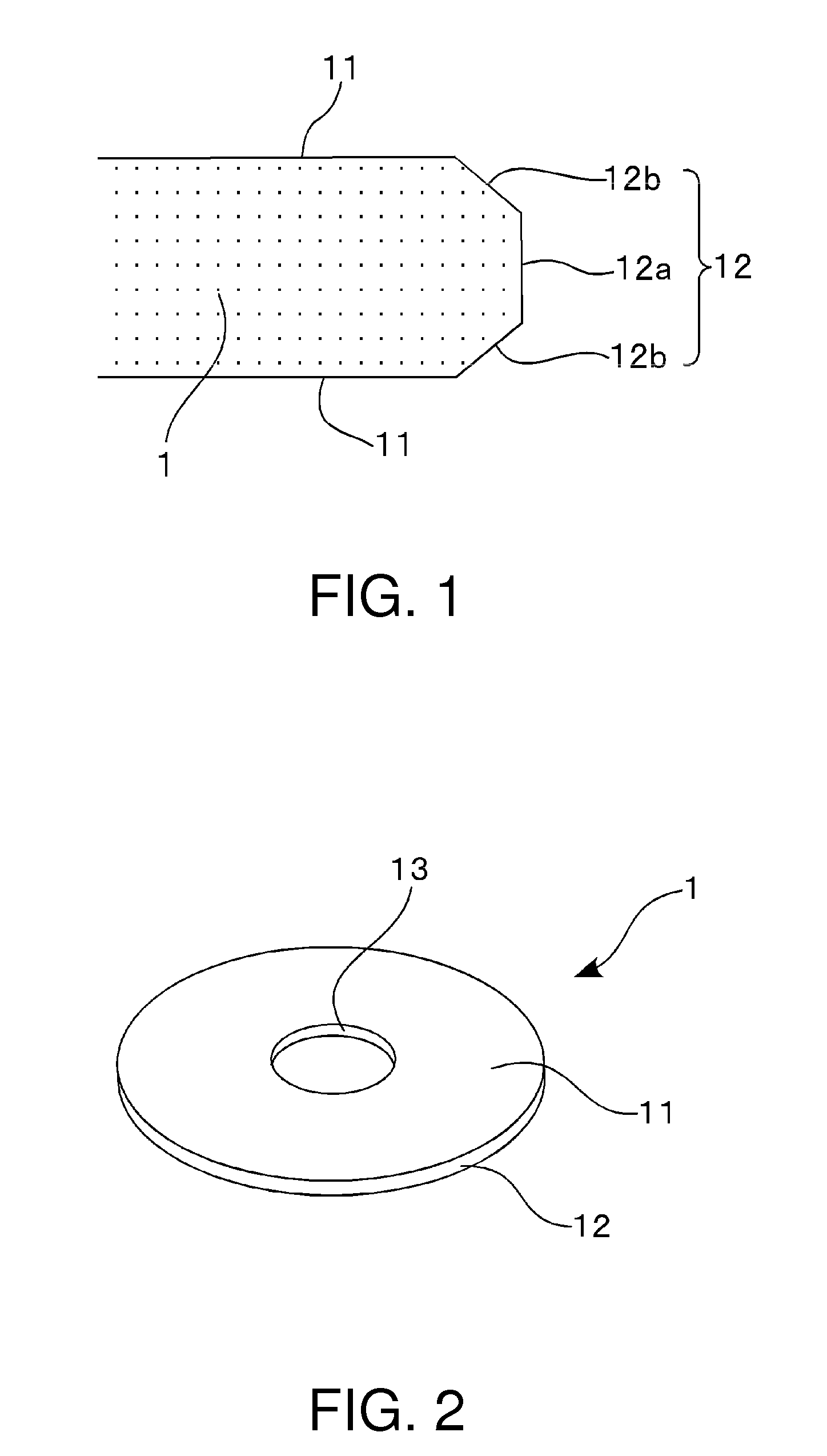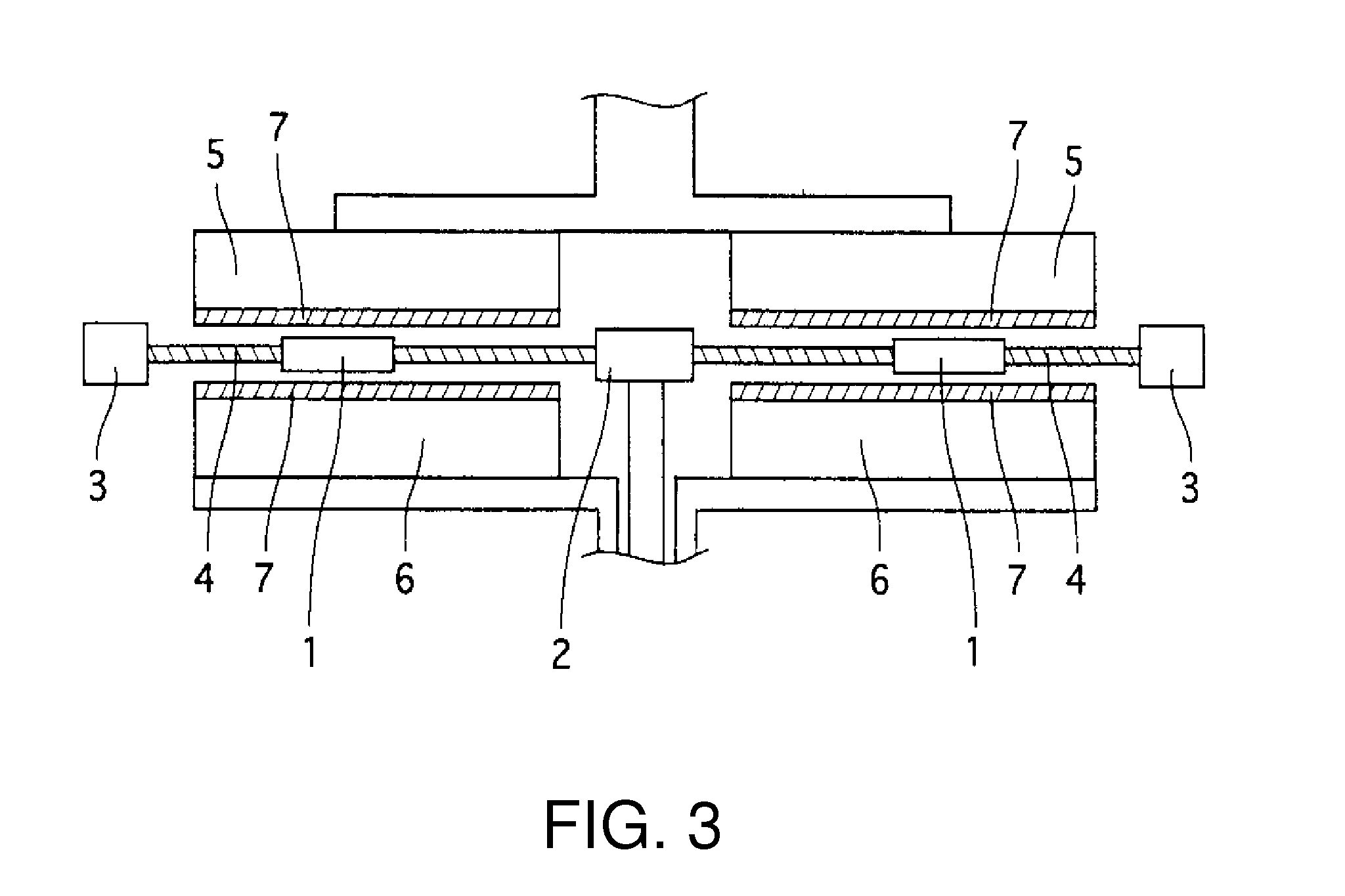Method of manufacturing a glass substrate for a magnetic disk and method of manufacturing a magnetic disk
a glass substrate and magnetic disk technology, applied in the field of manufacturing a glass substrate for a magnetic disk and a manufacturing method of a magnetic disk, can solve the problems of increasing the possibility of collision with the magnetic head, increasing the roughness, and increasing the error rate of reading or writing a magnetic signal, so as to achieve less surface defects, high polishing rate, and low cost
- Summary
- Abstract
- Description
- Claims
- Application Information
AI Technical Summary
Benefits of technology
Problems solved by technology
Method used
Image
Examples
example 1
[0083]A magnetic disk glass substrate of this Example was manufactured through (1) Rough Lapping Process (Rough Grinding Process), (2) Shaping Process, (3) Precision Lapping Process (Precision Grinding Process), (4) End Face Polishing Process, (5) Main Surface First Polishing Process, (6) Chemical Strengthening Process, and (7) Main Surface Second Polishing Process, which will be described hereinbelow.
[0084](1) Rough Lapping Process
[0085]First, a disk-shaped glass substrate made of an aluminosilicate glass and having a diameter of 66 mm and a thickness of 1.0 mm was obtained from a molten glass by direct pressing using upper, lower, and drum molds. Alternatively, a plate glass may be manufactured by a downdraw method or a float method and then cut into a disk-shaped glass substrate with a predetermined size. As the aluminosilicate glass, use was made of a glass for chemical strengthening containing 58 wt % to 75 wt % SiO2, 5 wt % to 23 wt % Al2O3, 3 wt % to 10 wt % Li2O, and 4 wt % ...
example 2
[0107]The second polishing process was carried out in the same manner as in Example 1 except that the friction coefficient between each polishing pad and the glass substrate was adjusted to 0.038 using a polishing liquid added with 0.1 wt % Aron A-6016A. Magnetic disk glass substrates were obtained in the same manner as in Example 1 except for this second polishing process.
[0108]The surface roughness of main surfaces of the obtained 100 glass substrates was measured using an atomic force microscope (AFM). As a result, the surface roughness was 0.143 nm in Ra, representing an ultra-smooth surface smoother than a conventional product. Further, a scratch evaluation was carried out in the same manner as in Example 1.
[0109]In Table 1 given later, the above-mentioned Ra value, a scratch evaluation, and a polishing rate value in the above-mentioned second polishing process are shown. According to this Example, while maintaining the high polishing rate, it is possible to further reduce surf...
example 3
[0110]The second polishing process was carried out in the same manner as in Example 1 except that the friction coefficient between each polishing pad and the glass substrate was adjusted to 0.048 using a polishing liquid added with 0.05 wt % Aron A-6016A. Magnetic disk glass substrates were obtained in the same manner as in Example 1 except for this second polishing process.
[0111]The surface roughness of main surfaces of the obtained 100 glass substrates was measured using an atomic force microscope (AFM). As a result, the surface roughness was 0.146 nm in Ra, representing an ultra-smooth surface smoother than a conventional product. Further, a scratch evaluation was carried out in the same manner as in Example 1.
[0112]In Table 1 given later, the above-mentioned Ra value, a scratch evaluation, and a polishing rate value in the above-mentioned second polishing process are shown. According to this Example, while maintaining the high polishing rate, it is possible to further reduce sur...
PUM
| Property | Measurement | Unit |
|---|---|---|
| Mass | aaaaa | aaaaa |
| Speed | aaaaa | aaaaa |
| Particle size | aaaaa | aaaaa |
Abstract
Description
Claims
Application Information
 Login to View More
Login to View More - R&D
- Intellectual Property
- Life Sciences
- Materials
- Tech Scout
- Unparalleled Data Quality
- Higher Quality Content
- 60% Fewer Hallucinations
Browse by: Latest US Patents, China's latest patents, Technical Efficacy Thesaurus, Application Domain, Technology Topic, Popular Technical Reports.
© 2025 PatSnap. All rights reserved.Legal|Privacy policy|Modern Slavery Act Transparency Statement|Sitemap|About US| Contact US: help@patsnap.com



